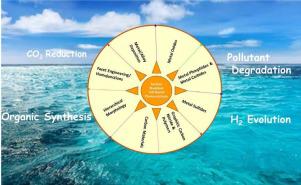Journal of Environmental Chemical Engineering ( IF 7.4 ) Pub Date : 2020-07-31 , DOI: 10.1016/j.jece.2020.104313 S. Girish Kumar , R. Kavitha , P.M. Nithya

|
Semiconductor mediated photocatalysis is envisaged as a promising approach to initiate the diverse redox reactions under the ambient conditions. Although titania still remains as benchmark photocatalyst, its wide band gap and rapid charge carrier recombination blights their utility under natural solar light. Thus, search of functional materials with narrow gap and suitable band edge potentials has drawn significant attention for photocatalytic applications. Towards this end, CdS have been impressive as prime nanomaterial which is mainly attributed to their visible light absorption capacity, more negative conduction band edge potential, and simplistic preparation with diverse morphologies and their proficiency to form stable heterostructure with variety of co-catalysts. However, photocorrosion vulnerability of CdS becomes the origin of intimidation for long term operations and massive charge carrier recombination constrains their performance. In this review article, surface structure of the CdS is modified with various co-catalysts such as metal NPs, metal oxides, sulfides, phosphides, carbides, g-C3N4, polymers and carbon materials to overcome the aforementioned drawbacks is discussed. Besides, fundamental aspects concerning the relationship between the crystal structure and morphological effects of CdS on the photocatalytic property is emphasized. The preparative methods, charge carrier dynamics and performance of CdS-based binary and ternary composites benefitting the model reactions such as pollutant degradation, hydrogen evolution and organic functional group transformation is reviewed in detail. The literature survey concludes that the surface modifications with co-catalysts can be the constructive approach for exploring the CdS based nanomaterials for broader environmental applications.
中文翻译:

为光催化应用量身定制CdS表面结构
设想将半导体介导的光催化作为在环境条件下引发各种氧化还原反应的有前途的方法。尽管二氧化钛仍然作为基准光催化剂,但其宽带隙和快速的载流子重组在自然光下会削弱其实用性。因此,寻找具有窄的间隙和合适的带边缘电势的功能材料已经引起了光催化应用的极大关注。为此,CdS作为主要的纳米材料令人印象深刻,主要归因于其可见光吸收能力,更多的负导带边缘电势以及具有多种形态的简单制备方法以及它们能够形成具有多种助催化剂的稳定异质结构的能力。然而,CdS的光腐蚀脆弱性成为长期操作受到威胁的根源,并且大规模的载流子重组会限制其性能。在这篇综述文章中,CdS的表面结构被各种助催化剂修饰,例如金属NP,金属氧化物,硫化物,磷化物,碳化物,gC3 Ñ 4,聚合物和碳材料,以克服上述缺点进行了讨论。另外,强调了有关CdS的晶体结构和形态对光催化性能的关系的基本方面。详细介绍了基于CdS的二元和三元复合材料的制备方法,电荷载流子动力学和性能,这些方法有利于模型反应,例如污染物降解,氢释放和有机官能团转化。文献调查得出的结论是,用助催化剂进行的表面改性可能是探索基于CdS的纳米材料在更广泛的环境应用中的建设性方法。











































 京公网安备 11010802027423号
京公网安备 11010802027423号